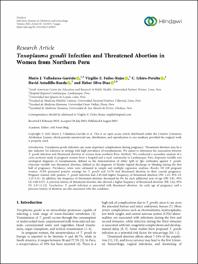Toxoplasma gondii Infection and Threatened Abortion in Women from Northern Peru

View/
Download
(application/pdf: 488.9Kb)
(application/pdf: 488.9Kb)
Date
2022-08-08Author(s)
Valladares-Garrido, Mario J.
Failoc-Rojas, Virgilio E.
Peralta, C. Ichiro
Astudillo-Rueda, David
Silva-Díaz, Heber
Metadata
Show full item recordAbstract
Introduction. Toxoplasma gondii infection can cause important complications during pregnancy. Threatened abortion may be a late indicator for infection in settings with high prevalence of toxoplasmosis. We aimed to determine the association between T. gondii infection and threatened abortion in women from northern Peru. Methods. We conducted a secondary analysis of a cross-sectional study in pregnant women from a hospital and a rural community in Lambayeque, Peru. Exposure variable was serological diagnosis of toxoplasmosis, defined as the demonstration of either IgM or IgG antibodies against T. gondii. Outcome variable was threatened abortion, defined as the diagnosis of bloody vaginal discharge or bleeding during the first half of pregnancy. Prevalence ratios were estimated in simple and multiple regression analyses. Results. Of 218 pregnant women, 35.8% presented positive serology for T. gondii and 14.7% had threatened abortion in their current pregnancy. Pregnant women with positive T. gondii infection had 2.45-fold higher frequency of threatened abortion (PR: 2.45, 95% CI: 1.15-5.21). In addition, the frequency of threatened abortion decreased by 9% for each additional year of age (PR: 0.91, 95% CI: 0.86-0.97). A previous history of threatened abortion also showed a higher frequency of threatened abortion (PR: 5.22, 95% CI: 2.45-11.12). Conclusions. T. gondii infection is associated with threatened abortion. An early age of pregnancy and a previous history of abortion are also associated with this condition.
Subject
Collections
- SCOPUS [380]

